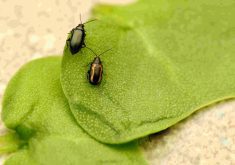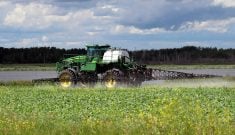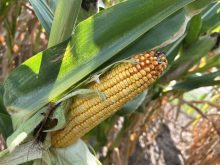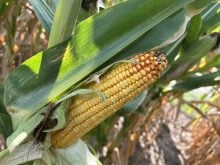The pea leaf weevil has a biology that’s a real pain in the anatomy when growing field peas or faba beans.
Whatever the management strategy, the beetle shrugs and walks away pretty much unscathed. Agriculture Canada entomologist Meghan Vankosky in Saskatoon has spent the last few years looking at the weevil’s biology to find a control.
“It’s been confounding people for quite a long time,” she said. “It was introduced to Canada in the early ‘90s and has been a pest in the Pacific Northwest in the United States for a number of years.”
Read Also
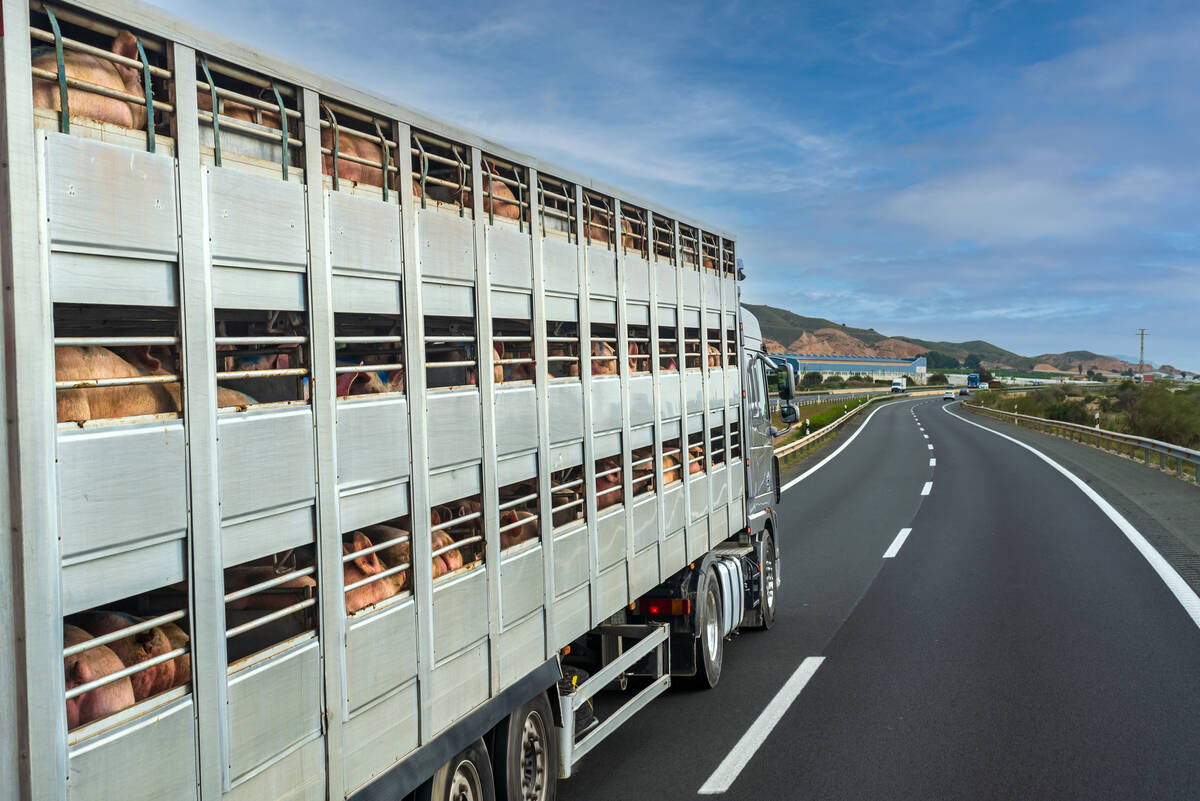
Pig shipments to U.S. slow as new COOL looms
A Manitoba pork marketer says some U.S. processors have shut their doors to Canadian pigs as enforcement of U.S. voluntary country of origin labelling (vCOOL) looms.
Like many agricultural pests, the pea leaf weevil isn’t native to North America. It’s widespread in Europe and in parts of Asia and Africa, and although the adults will feed on many green plants, they must lay eggs on field peas or faba beans. Their larvae are particular to these crops but the adults are a bit more cosmopolitan in their diets.
“The weevils overwinter as adults but before they overwinter, they feed on alfalfa and they’re not very picky at this time,” said entomologist Hector Carcamo of Agriculture and Agri-Food Canada in Lethbridge. “Anything green, especially if it’s in the family fabacea, any kind of bean, alfalfa, clover, they will feed on it and overwinter there.”
Most overwintering insects go through a period of diapause, a state of dormancy they enter when the going gets tough. Development is stopped and the insect waits it out until conditions improve.
Hibernation is a form of diapause and many insects do this during winter, some as adults and others as larvae or pupae. Many are programmed to emerge from diapause when they get specific signals such as day length or a certain temperature.
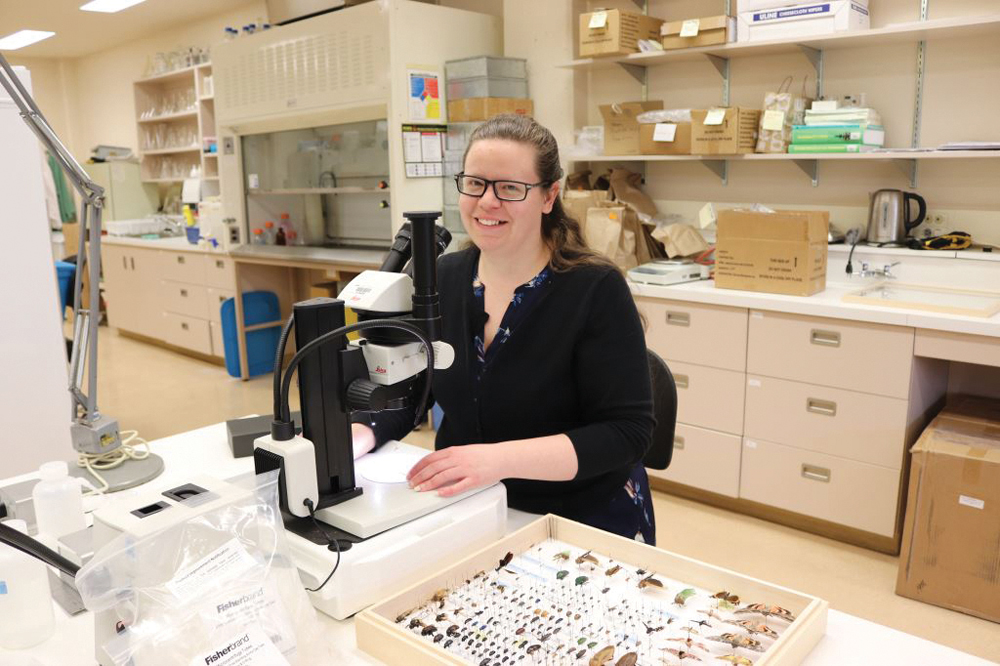
“This insect has obligatory diapause so when it’s gone to sleep, it’s sleeping like a rock. It’s not going to wake up until its time comes,” Carcamo said. “But with pea leaf weevil, it can wake up a little bit early. It seems to have something of a facultative diapause, meaning that it doesn’t go entirely to sleep. It’s kind of like a grizzly bear, it can wake up anytime.”
Once emerged, they feed on whatever they can find and as soon as they smell emerging peas or faba beans, they find them.
“This insect can fly a long distance,” said Carcamo. “We don’t know exactly how long they can fly but they can fly a few kilometres.”
At that point many insect pests would be vulnerable to insecticides but pea leaf weevils’ combination of staggered emergence and flying endurance make them hard to control.
“Some of them wake up early, some of them wake up later and then you have these waves of pesky weevils coming into your field,” Carcamo said. “So you spray today and in a few days you get another wave of insects. Your spray was for nothing.”
Thiamethoxam, a neonicotinoid seed treatment, is registered for pea leaf weevil and does get some results.
“It causes paralysis and if the weevils remain paralyzed for long enough after feeding, then they’ll starve to death,” Vankosky said. “The idea is that we’re killing them before they can lay their eggs or, if we’re not killing them, we’re delaying egg laying so that the root nodules have time to establish and start supporting the plant.”
A female weevil can lay 1,000 to 1,500 eggs over a season. The eggs hatch and the larvae drop into the soil. This is the stage that actually does the damage and it’s unclear whether a seed treated insecticide translocates to the roots. It may cause some larval mortality but not enough.
“We tend to see that damage below the ground may be reduced but it’s usually not significant compared to the control group because it doesn’t take a lot of weevil eggs to create enough larvae to do a lot of damage below the ground,” Vankosky said.
“So, again, it’s a very tricky system but the hope is that you can delay everything long enough so the plants get better established and can withstand some damage.”
The larvae pupate in the soil and the next generation of adults emerges in late July and early August. They look for any remaining pulses or legumes and feed until fall, when they prepare to overwinter and enter diapause. They need this time to grow into their reproductive stage and get ready for spring.
The pea leaf weevil’s seemingly simple biology makes it a complicated pest to manage. Farmers need to find its weak spot. It likes moist soil and numbers tend to drop during drier summers. Its preferences may make it vulnerable to trap crops, and some insect predators will eat the weevil and its eggs.
Management may require an integrated approach with careful monitoring and attention to weather and new developments in pesticides, trap crops and biological control.
“There are certainly challenges there and we are in its infancy in terms of studying the different components of that potential program,” Vankosky said.
“My goal for pea leaf weevil management is certainly an integrated approach that can be quite complex even though we ideally want a simple integrated approach.”
Biocontrol not an easy feat
Back in its old country home, a problem pest can be kept in check by a host of natural enemies, whether they’re predators, parasites or some kind of disease. Introducing one of those adversaries here can sometimes provide control.
Would the pea leaf weevil be a good candidate for biological control? According to entomologist Meghan Vankosky, the answer is yes and no.
“In terms of a classical biocontrol program, I don’t think that the potential is very high,” she said. “They’ve never had any luck to find a biocontrol agent in Europe, Africa or Asia that is highly specific or has a significant impact on their populations.”
In the classical program, a predator, parasite or parasitoid is found that likes the target but has no interest in other species.
One example of biocontrol gone wrong is the introduction of the mongoose into the Caribbean islands to control brown rats in sugar cane fields. Though mongooses like the rats in their homeland, they liked many of the native Caribbean animals even more and several species were decimated. They also developed a taste for domestic chickens.
We might not be able to import a predator but that doesn’t mean there aren’t any here already. When Vankosky was a grad student, she found something encouraging.
“There’s a very small beetle, Bembidion quadrimaculatum, that loves to eat pea leaf weevil eggs,” she said. “They ate 100 per cent of the eggs that we gave them in 24-48 hours.
“I’m also working with a student at the University of Alberta who’s been looking into predation of adult pea leaf weevil by adult ground beetles. We know that they will eat them but, again, quantifying the impact of that predation in the field is difficult.”
What happens in the lab may not translate into the field because predators may behave differently in a more complex environment. Most predators are not fussy. They’ll eat whatever they can catch and whatever fits in their mouths. They may eat pea leaf weevils and eggs but that is difficult to determine.
“With different techniques like gut content analyses, pea leaf weevil DNA in the gut of a carabid beetle, maybe that would be possible, but it’s not something we’ve looked into yet,” Vankosky said. “I’m curious to know if any native parasitoid species have decided that pea leaf weevil is a good host and that might be using it. That could be an avenue for some conservation biocontrol.”
Caught in a trap (crop)
A few years ago, Meghan Vankosky and a colleague were sweeping for grasshoppers in southern Saskatchewan. Close to where they parked, they found a harvested pea field with all kinds of volunteer peas coming up.
“We could see pea leaf weevil notches all over those seedlings, which made me think that late in the season, a young pea seedling would be very attractive,” she said. “So we wrote a proposal to the pulse cluster to study trap crops and other alternative management options for pea leaf weevils.”
A trap crop is just that. Since these late peas would be irresistible to the new generation of weevils headed for hibernation, it could be a workable way to concentrate them in a relatively small area.
“So we looked into using the two primary hosts, field peas and faba beans, as trap crops, both in the spring and then late in the summer,” she said. “Both crops are highly attractive at any time of year so they can be used as a trap crop. But then the next question is, once we have them in a trap crop, how do we kill them most effectively? So that, I think, is the next step in this particular problem.”
Entomologist Hector Carcamo of Agriculture and Agri-Food Canada suggested a further step that uses the weevil’s taste in target crops and also strikes at its odd winter diapause. It doesn’t drop into a complete sleep like many insects. It’s easily awakened.
“Because they wake up so early, ideally somebody should breed a field pea or a faba bean that can be planted in the fall and then survive the winter,” he said. “It can be up early on or even start growing in the winter and then have a lot of foliage to attract the weevil early on.”
Combined with a seed treatment and an early spraying program, it could be part of an effective integrated method for pea leaf weevil control.




